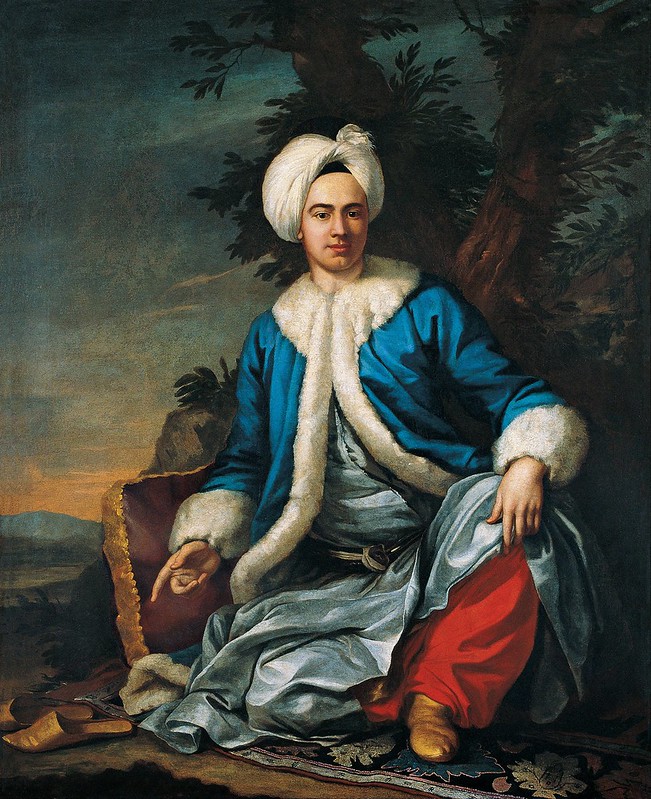Obra d'Antoine de Favray (1706-1798), pintor francès (1)
- Recordatori de Marie-Martin Marcel Marin -
En el dia de la celebració del seu 246è aniversari de naixement
Parlem de Pintura...
Chevalier Antoine de Favray (Bagnolet, 8 de setembre de 1706 - Malta, 9 de febrer de 1798) va ser un pintor francès. Es va formar a Roma amb Jean-François de Troy abans d'establir-se i treballar a Malta. Allà va viure la major part de la seva vida exceptuant el període 1760-1770, dècada que va viure a Constantinople. Va ser dels pocs pintors europeus que va desenvolupar la seva carrera a l'illa de Malta. Va morir en aquesta ciutat el febrer de 1798.
Font: En català: No disponible - En castellano: No disponible - In english: Antoine de Favray (1706-1798) - Altres: Antoine de Favray (1706-1798)
Parlem de Música...
Marie-Martin Marcel Marin (Saint Jean-de-Luz, 8 de setembre de 1769 - Toulouse, c.1830) va ser un arpista i compositor francès d'ascendència italiana. Fill del violinista Guillaume Marcel de Marin (1737-c.1800), es va formar amb el seu pare. Ben aviat va viatjar a Itàlia on es va formar amb Nardini al violí. Posteriorment es va instal·lar a París on va estudiar arpa amb Christian Hochbrucker i Krumpholtz. Als 14 anys va entrar com a membre de l'Acadèmia Arcadia de Roma tot demostrant la seva precocitat musical. Després d'un breu període militar a França, va viatjar per Europa el 1786. Va emigrar a Anglaterra després de la Revolució Francesa. Allà va treballar com a professor i compositor. Anys més tard es va retirar a Toulouse on va seguir interpretant en salons i en cercles privats. D'estil eminentment clàssic, va publicar nombroses obres per a arpa a París i Londres incloent les Sonates Opp. 6, 10, 15 i 16. També va escriure obres per arpa amb violí o piano, quintets, quartets de corda i arranjaments d'obres de Mozart i Beethoven. Va morir a Toulouse en una data desconeguda.
Font: En català: No disponible - En castellano: Marie-Martin Marcel Marin (1769-c.1830) - In english: Marie-Martin Marcel Marin (1769-c.1830) - Altres: Marie-Martin Marcel Marin (1769-c.1830)
Parlem en veu pròpia o en veu d'altri...
Having returned to France, he entered Versailles’ Military Academy from which he emerged as a captain in 1788. Soon after he obtained a leave to travel; he visited Austria, Prussia and Spain, putting to good use everything he heard and so developing further his triple talent as a violinist, harpist and composer. Far from home at the time of the French Revolution, he was placed on the list of absentees and his properties were expropriated. As his requests to be admitted back into his motherland went unheeded, he decided to go to England. It is here where his skilfulness with the harp reached its zenith of perfection as his gentlemanly qualities and his personal beauty, the nobility of his manners and the variety of his teaching were fully recognized. On his return to France his properties were finally restituted and he retired to Toulouse, where he found alleviation in music. Labarre who in his youth had the chance of listening to, and playing before, Marin Marie Martin understood this artist’s merit and decided to be part of his school. In sum, Marin’s music is truly classical in spirit and will remain as a model for generations of composing harpists.
The Nocturne in Quintet op. 14 is his only piece for harp and a string quartet. The introduction, in the form of an Adagio, is a direct immersion into the romantic atmosphere of this piece. It is followed by a quasi-adagio Andantino, which intertwines the harp and string melodies and a lively and rigorous Allegro Agitato and an Adagio that recalls the beginning of the piece and is linked to a classical Minuetto. A Cossack in Rondeau, which demands great technical mastery from the harp concludes this piece beautifully. The first of the two trios for violin, cello and harp on themes by Mozart starts with an Andante Grazioso inspired in the Andante from Piano Trio K542 followed by the Turkish March of the Piano Sonata K331. The Adagio in the second trio takes its inspiration in the adagio of Piano Trio K254 while its Allegretto con Variazioni is inspired in the Allegro from the Violin Sonata K481. The New Grand Sonata opus 31 was written when he was a Cavalry Colonel and consists of four movements. The first is an Adagio; the second is an Allegro Maestoso, which highlights the technical difficulties of the piece and demands a bewildering articulation; the third is an Andante that develops a monotonous chant that is dressed in virtuoso adornments; and the fourth is a classical Rondo. This great sonata is a musical and technical challenge for the harp.
Harp & Co
Gaudiu i compartiu!
Informació addicional...
PRESTOMUSIC: MARIN, M.M.M. - The School of Harp in France Vol.1
CPDL: No disponible


Un administrador del blog ha eliminat aquest comentari.
ResponEliminaUn administrador del blog ha eliminat aquest comentari.
EliminaGreat CD. Thanks!
ResponEliminaUn administrador del blog ha eliminat aquest comentari.
ResponElimina